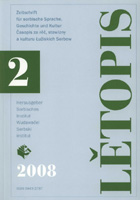Sorbenbilder im Fadenkreuz deutsch-nationaler Propaganda
Images of Sorbs as Targets of German-Nationalist Propaganda
Author(s): Maria MirtschinSubject(s): Cultural Essay, Political Essay, Societal Essay
Published by: Domowina-Verlag GmbH / Ludowe nakładnistwo Domowina
Keywords: sorbs; image; propaganda; german; nationalist
Summary/Abstract: Two wall paintings in the school of the housing estate for the Erika mine are part of the decoration of the public buildings there. They portray the taking-over of the heathland by industrialization as an act of German cultural sabotage in the tradition of early Christianization. This theme is based on the alleged discovery of chronicles from the sixteenth century, which turned out to be fakes. In the tympanum of the church which was consecrated in 1939 a Sorbian woman is kneeling, dressed in folk costume. Despite the ban on Sorbian activities in public the Sorbian way of life had a presence in Lusatia, which had to be acknowledged. Two wall paintings for the Olympic Village in Berlin by the painter, Gerhard Keil, which portrayed Sorbian churchgoers, caused controversy in 1936. The Ministry of Propaganda demanded the omission of everything, which indicated “the existence of a particular Wendish people in the Reich.” This edict was adhered to by the removal of the banners; the figures remained. This inconsistency expressed the ambivalent attitude of the authorities towards the Sorbs. The folk costumes in any case fitted in with the way in which the Nazis glorified the idea of the homeland.
- Issue Year: 2008
- Issue No: 2
- Page Range: 3-16
- Page Count: 14
- Language: German
- Content File-PDF

